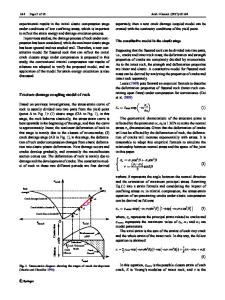Experimental verification of the strain-gradient plasticity model for indentation
- PDF / 793,680 Bytes
- 7 Pages / 612 x 792 pts (letter) Page_size
- 95 Downloads / 356 Views
The indentation size effect of pure iron samples with various pre-plastic tensile strains has been experimentally investigated and analyzed. With the increase in the strain, the indentation size effect of iron samples becomes weak, accompanied by the multiplication of the statistically stored dislocations. All of the hardness (H) versus indentation depth (h) curves fit the strain-gradient plasticity model for indentation of Nix and Gao well. Two fitting parameters, the hardness in the limit of infinite depth (H0) and the characteristic length (h*), were obtained for each curve. The hardness (H0) of iron samples can also be estimated as the microhardness (H) at a very large depth, h ≅ 10h*. Both the fitted H0 and the measured H0⬘ increase linearly with the tensile yield stress y of iron samples, indicating a dependence of H0 on the statistically stored dislocation density through y. Furthermore, 1/√h* shows a linear increase with the tensile yield stress y, which also agrees qualitatively with the general prediction of the Nix and Gao theory. Therefore, our experiments and analysis demonstrate that the strain-gradient plasticity model for indentation of Nix and Gao can interpret the indentation size effect with satisfied precision.
I. INTRODUCTION
During the last 20 years, with the development of surface coatings and nanotechnology, understanding the mechanical properties of ever smaller volumes, such as thin films and microelectromechanical systems (MEMS), has become more urgent.1–3 The reason is attributed not only to the reliability of MEMS being determined by their mechanical properties, but also to the microscale mechanical properties that may differ from bulk properties due to the size effect and the surface effect.4–6 As a guide of the material’s ability against microdeformation and of the thin film’s ability against wear, nanoindentation hardness has been widely studied.1,2,7 Different from the microhardness, the determination of the nanoindentation hardness usually uses the depth-sensing indentation technique which obviates the need for imaging the residual indent.7 Plenty of indentation results have shown that the nanoindentation hardness of materials increased with the decrease in the indentation depth within the submicrometer range, which is well known as the indentation size effect.8–17 The indentation size effect is
a)
Address all correspondence to this author. e-mail: [email protected] DOI: 10.1557/JMR.2005.0395
extensively investigated in literature, but the mechanisms driving it are not yet well understood. The typical suggested mechanisms include the inadequate measurement capabilities of extremely small indents,8 the presence of oxides or chemical contamination on the surface,9 indenter– specimen friction,10 and increased dominance of edge effects11 or free surface energy12 with shallow indents. Recently, a dislocation-based model of strain-gradient plasticity, which involves the interaction between the statistically stored dislocations and geometrically necessary dislocations, was pr
Data Loading...











